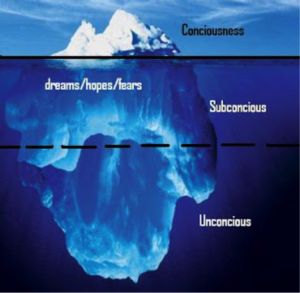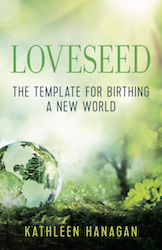
“Until you make the unconscious conscious, it will direct your life and you will call it fate.”― C.G. Jung
Right below the surface of our lives are the dreams, hopes and fears that direct our language and behavior in ways we rarely question. Someone asks us how we are, and we respond with “Just getting by,” which tells a whole story about scarcity that may be rumbling inside. Or we respond with, “Fighting the good fight,” as our need to feel heroic is expressed in broad daylight. Or we sigh, smile, and respond with, “You don’t want to know,” which is code for feeling overwhelmed and alone, and just not wanting to use the energy to share.
Something yet deeper than our dreams, hopes and fears is always percolating. The more we face and embrace our own depths, the more ability we have to be a conscious co-creator in our lives. ![]()
What is this unconscious that has so much power in our lives? It is useful to go back to a time when the field of psychology was newly-emergent. Freud had discovered the unconscious, and radical new understandings of human beings and their development were being discovered by great and curious minds. Carl Jung was one of Freud’s most prominent students, and eventually broke with Freud over basic differences in how each viewed the psyche. There are more than 400 documented references to pathology in the writings of Freud, and yet nothing devoted to healthy functioning.
Jung, on the other hand, was teleologically-oriented and focused on what is right or whole within us. Teleological comes from the Greek teleos and refers to aphilosophical interpretation of nature and natural phenomena as possessing purpose or design. Everythingis seen as purposeful in the service of self-actualization and healing. That includes symptoms, which Jung believed had meaning and are here to communicate what we need for our transformation to a higher order.
In Jung’s view, depression, anxiety, and even psychosis are purposeful, and the role of the healer is to activate the transformation toward wholeness. The healer does not heal but guides the person to tap into his or her innate wholeness, or the loveseed inside. I concur with Jung, and I continue to experience awe as clients make shifts that are utterly courageous and from a far higher ground than the aggressive instincts that Freud believed to be the main drive of human beings.
We are also deeply indebted to Freud for discovering and identifying the existence of the unconscious or unseen aspects of human nature. He believed that the first five years of life are key formative years that create lifelong patterns, and he discovered and named the defense mechanisms of the ego. He believed that the die is cast young, and his work did not venture into the realm of Spirit where unseen forces can assist a person in making remarkable, and at times, radical transformations.
Jung, on the other hand, drew a more expansive and hopeful picture of a personal unconscious; a familial unconscious where beliefs and psychic patterns are passed down; a cultural unconscious that holds our tribal and religious heritages, as well as the collective unconscious—a storehouse of the universal archetypal patterns from the archives of humanity that each and every one of us carries. The word archetype means “original,” and archetypes are our original templates or blueprints.
Jung believed that this innate drive toward our own wholeness is an inherited universal drive; part of the basic template of humanity. He called this drive individuation, which is a developmental process over time in which an individual moves further away from the divided and civilized self and closer to the true and undivided Self. In order to do this, we must own and release all that is not who we are. Before any wholeness can be found, we must each experience our brokenness, which leads us to our depths so that we may find the hidden unity in all things.
To Jung, the great enemy of mankind was normalcy – the attempt to fit in by contorting who you really are, thus creating a persona that is not you, and that you then present to the world as you.The danger is that you are lulled to sleep with this false sense of self, and you fail to realize it is not you. This is a state of being in which your personal drive for wholeness is rendered dormant, which for Jung was the only real “sin.” I call it the Trance.
At this point in our world, the number of distractions for each of us at the conscious level is keeping us from diving into our depths. There has never been a greater need, and never been a greater pull not to do that holy work. We must decide to see illness, depression, and personal tragedy as the unwelcome opportunities to become whole, even as we embrace the feelings of victimhood that accompany them. ![]()
Transformational deep diving can be done in countless ways, from ayhuasca retreats, breathwork, brainspotting, somatic work, and even 5 Rhythms dance, one of my favorites. It involve the whole person—body, mind and spirit—getting out of the head and into the body where the unconscious manifests.
This is the work of transformation, which is what changes the world.
May I have the courage to become quiet enough to pay attention to my own depths.
May I have the wisdom to understand the messages that come from my depths,
May I have the heart to embrace all the parts of me I have left behind.



Thank you for your wise words, Kathleen! As someone who has spent a great deal of my life being depressed, it is always heartening to know that it is a useful experience. It can help us forward eventually. I love hearing about Jung, he had some amazing ideas. Thank you!